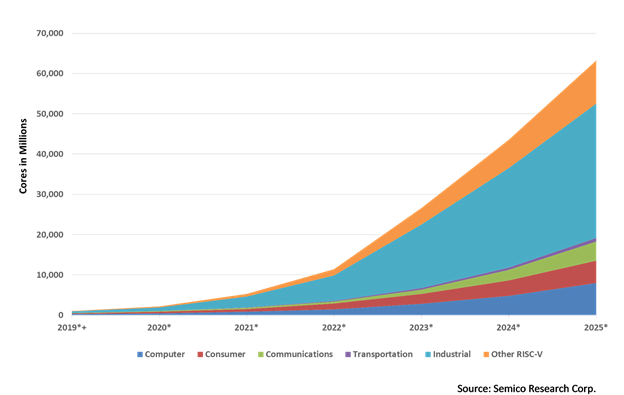Trade War Concerns Push RISC-V to Move HQ
Article By : Nitin Dahad

Members vote unanimously to move HQ to Switzerland as they face challenges from customers about source of IP
The RISC-V Foundation is moving its headquarters from the U.S. to Switzerland after concerns among its members of potential restrictions on the core technology that could arise from the U.S. China trade war.
Speaking to Reuters, the RISC-V Foundation’s CEO Calista Redmond said she wants to ensure that universities, governments and companies outside the United States can maintain access to and develop the open-source RISC-processor core technology. She said that its members, which include Qualcomm, NXP Semiconductors, Huawei and Alibaba, are concerned about possible geopolitical disruption.
She told the news agency, “From around the world, we’ve heard that ‘If the incorporation was not in the U.S., we would be a lot more comfortable.” The foundation’s board of directors – all seven of whom are based in the U.S. – approved the move unanimously. It’s expected that this will be expanded with the addition of European and Asian members once it moves to Switzerland.
Various companies are concerned about being challenged about the origins of its technology and intellectual property (IP). Member companies such as NXP said its customers have asked the company to specify the origins of the IP as they do not want to be cut off in future trade disputes. Also, Huawei is said to have responded to Reuters with the following statement: “We support RISC-V Foundation identifying Switzerland as a neutral venue for open source development. Making open source as open as possible is important for the industry.” The company added that RISC-V fits well into its vision of a heterogeneous, open world.
Charlie Su, CTO and EVP of Andes Technology told EE Times Europe, “This is the right move by the RISC-V Foundation, to show its first step toward a true international organization. The next step is to have an international board of directors to represent the interest of the wide membership.”
The RISC-V architecture, while being open source, evolved from the University of California, Berkeley, and from Defense Advanced Research Projects Agency (DARPA) funding. While members in the industry are quite unanimous in their support for the move, there is mixed response within government. William Reinsch, who was undersecretary of commerce for export administration in the Clinton administration, said the move from Delaware to Switzerland sends a strong message to the U.S. government. He said that if you clamp down on things too tightly, these kinds of moves would be inevitable in an industry reliant on an integrated global supply chain.
Republicans in the U.S. government feel security threats from Chinese companies exist and that this kind of move supports the Chinese government to circumvent its export control system; some are even outraged at the fact that a technology developed using American public funds was easily accessible to Chinese members of the RISC-V Foundation.
Meanwhile Calista Redmond said to Reuters that since the technology is open source and available to anyone, she does not see how the move could be against the U.S. national interest. This is a view that DARPA apparently supports, where a spokesman said the RISC-V work it funded was meant to be publicly available to companies and academics around the world.
Industrial and 5G Drive Market

In its latest report, “RISC-V Market Analysis: The New Kid on the Block”, Semico Research estimates the market will consume a total of 62.4 billion RISC-V CPU cores by 2025, with the industrial sector forecasted to be the largest segment with 16.7 billion cores. Forecasting the compound annual growth rate (CAGR) for RISC-V CPU cores, Semico estimates that segments including the computer, consumer, communication, transportation and industrial markets will see a 146.2 percent CAGR on average between 2018 and 2025.
Semico surveyed a cross section of companies in the RISC-V ecosystem and the broad market to analyze the market potential for RISC-V CPU cores. As part of this research Semico evaluated 25 markets to develop a forecast for the penetration rate of RISC-V, along with the number of cores that would be implemented over time. The firm analyzed data for 25 applications within five major end markets – computer, consumer, communications, transportation and industrial – to develop a forecast for four product categories: advanced performance multicore systems on chip (SoCs), value multicore SoCs, basic SoCs and FPGAs.
Jim Feldhan, president of Semico Research, commented, “We were surprised and excited to see how companies of all sizes are designing RISC-V solutions for a wide variety of applications for various performance and volume requirements. Based on the already sizeable adoption of RISC-V, we forecast that the market will consume a total of 62.4 billion RISC-V cores by 2025, signalling that RISC-V is on the fast track to mainstream adoption.” Semico estimates that the deployment of 5G and the multitude of products and applications that will be enabled with the adoption of 5G technology will drive the largest growth rate for RISC-V CPU cores between 2018 and 2025. Transportation is estimated to have the second fastest CAGR due to the automotive industry’s growing focus on electrification and the increased adoption of CPU-based systems for safety, in-cabin experiences, driver assistance and wireless communications. Semico found that organizations are designing RISC-V solutions across a variety of performance and volume applications, as well as designing anywhere from one or two to more than 1000 cores in SoCs.
Subscribe to Newsletter
Test Qr code text s ss


